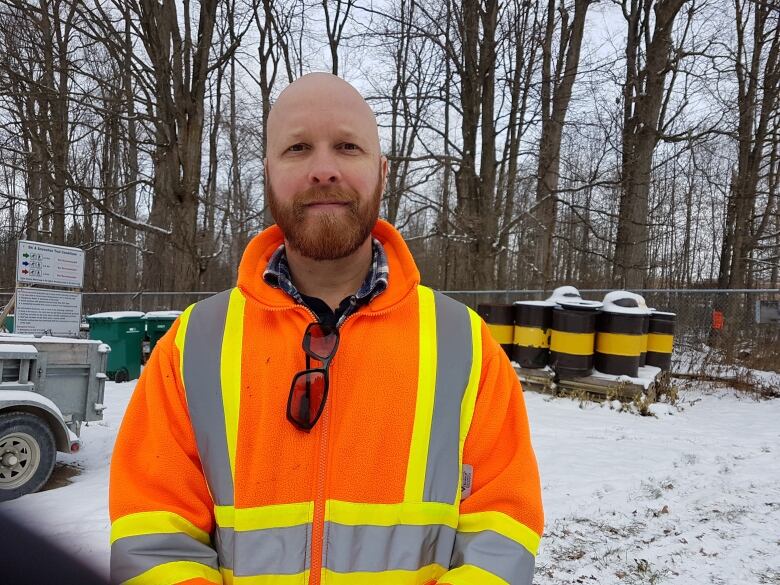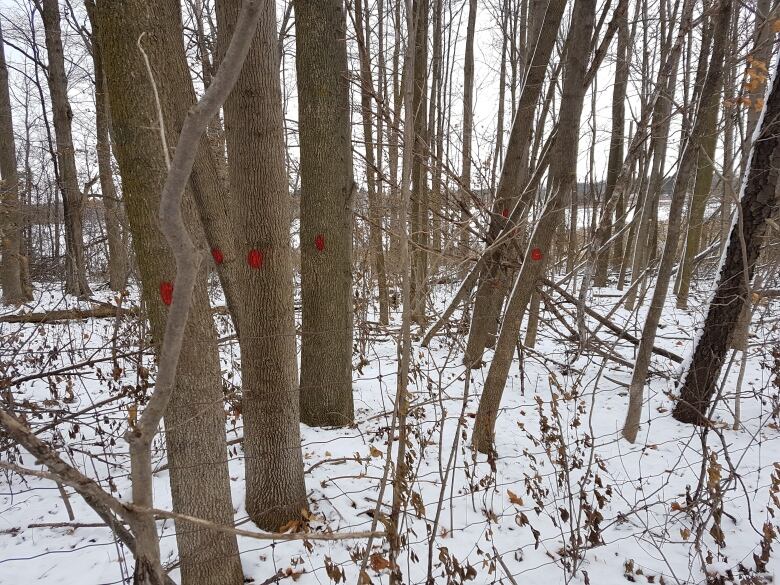Emerald ash borer stripping Grand River watershed forests
Grand River Conservation Authority plans to cut down 14,000 affected trees

When he signed up to be an arborist, Stephen McQuigge knew he would be dealing with damage caused by a little green beetle known as the emerald ash borer.
What he wasn't planning on was spending the past six years cutting down thousands of ash trees in the Grand River watershed.
- Costly beetle invasion will be quick and painful for Winnipeg, scientists say
- Who pays to cut down 70 dead or dying ash trees on Northfield Drive?
- Tree-killing ash borer makes Quebec City debut
"You can get it in your head, but not really get it with your heart until you start cutting everything down," he told CBC News. "So, I knew it was coming, but it is discouraging to be in the middle of it and have to remove all these trees."
McQuigge is the superintendent of arboriculture with Grand River Conservation Area, which manages 30,000 acres of forest in southwestern Ontario.

Laurel Creek hard hit
One of the areas hardest hit by the beetle is Laurel Creek Conservation Area, in north Waterloo, where McQuigge and his forestry crews have already cut down over 450 trees.
On a brisk December morning, three crews were working in the forest to take down an additional 100 trees before the end of the month.

Soon there will be more: a dozen or more ash trees in the same area have beenmarked with a red dot, signalling that they also have beeninfested by emerald ash borer.
'There's always a reason'
The devastation at Laurel Creek hasn't gone unnoticed by park visitors and people driving by.
"We have a lot of calls from people thinking that we're cutting down trees for no reason and that's simply not the case," McQuigge said. "There's always a reason when we take down a tree."

While the infested trees that are dead or dying have to be cut down, not all of them on conservation land will be felled. McQuigge said he's always asking himself the following questions:
- Is this tree going to fall down or partially fall down?
- If it falls down, is there a chance it will fall on a person or building?
- If it falls on a person or building, what will the damage be?
"We're not cutting down all of the ash trees," he said. "We're cutting down ash trees that threaten targets, like a trail or a nature centre where we have kids all the time or in our parks over our camp sites."

Leaving the trees to fell themselves is the most cost effective way of dealing with emerald ash borer, as there are an estimated 500,000 ash trees on conservation property and it can cost hundreds even thousands of dollars to fell a single tree.
A protection plan
Starting in 2014, the conservation authority budgeted $400,000 a year for up to 10 years to deal with damage caused by the beetle. Most of that money is spent on tree removal, but a small portion is going towards a special project.

- Restored hiking trail a victory in the war against emerald ash borer
- 'Made in Canada' wasps next step in battle against ash borer
- Scientists try to fight off emerald ash borer using fungus traps
Two years later, the same trees which were each marked with a green dot were treated a second time.
Wu-Winter said each tree takes up the chemical through it's "veins," which lie in the layer of wood just under the bark.
When emerald ash borer larvae eat this layer of wood, they ingest the chemical, leading them to stop eating and eventually die.
The chemical also makes its way up into the trees leaves, which are eaten by adult ash borers. The adults won't die from ingesting the insecticide, but its eggs will be infertile.
"Where we've started early enough, the trees seem to be surviving well," Wu-Winter said. "As long as the treatments start when the trees are relatively healthy and not impacted by the beetles, the treatments are quite effective."
However, he said TreeAzindoesn't work as wellwhen the treatment is administered later, even if the tree still looks healthy. It's because there is already a significant number of beetle larvae already in the tree and have "done some damage," and the chemical isn't absorbed and distributed as effectively.
There's a chance that over the long term, Wu-Winter said, some ash trees will develop a natural resistance to the beetle.
But for now, if we want to have ash trees in our future, he said injecting a few of them with insecticide is the only effective way of protecting and preserving them.












_(720p).jpg)


 OFFICIAL HD MUSIC VIDEO.jpg)
.jpg)



























































































